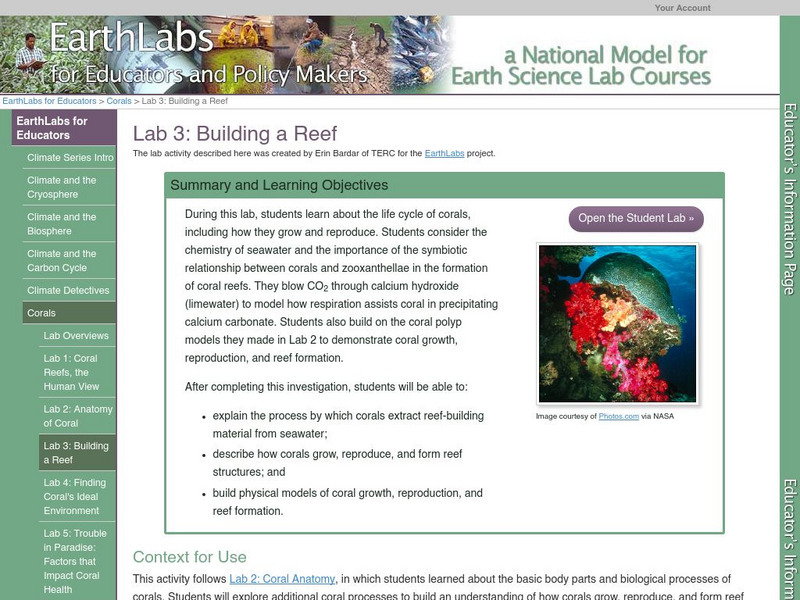Hi, what do you want to do?
Curated OER
Fish Fashion 101
Students explore fish anatomy. In this fish anatomy and adaptation instructional activity, students define and identify the location of fish body parts. Students add these parts of a fish's anatomy to a life-sized fish costume worn by a...
Curated OER
Coarl Reef Degradation
Students explore methods of preserving Hawaii's ocean ecosystem. Using underwater cameras, students take pictures of the underwater reef. They perform activities to determine the history and degradation of the coal reef. While...
Curated OER
Island Formation
Students create models of how islands are formed by hot spots and then write a summary of their observations and of how they think their model relates to volcanic hot spots and island formation.
Curated OER
the Potential Consequences of Climate Variability And Change
Learners analyze the consequences of changing variables on a system. Changes in a model are measured and recorded and conclusions drawn based on the data provided in this six lessons unit.
Curated OER
Island formation
Students explain what an island is, and distinguish islands from similar landforms. They compare and contrast the different ways in which islands are formed.
Alabama Learning Exchange
Scrapping the Biomes
Fifth graders investigate biomes of the earth. For this biomes lesson, 5th graders explore eight different biomes which include the tropical rain forest, deciduous forest, grasslands, and taiga. They design an artistic scrapbook that...
Curated OER
Oceanic Habitat Zones
Middle schoolers explore ocean habitats. In this oceanic environment lesson, students research various habitats in the ocean. Then, in a jigsaw format, middle schoolers teach others in the class about the habitat they researched.
Curated OER
Bermuda Today: Who Were Its Geologic Ancestors?
Students explore how the island of Bermuda came to be.
Curated OER
Dolphins at Daybreak
In this science related worksheet, students locate and circle eleven words associated with dolphins in a word search puzzle in the shape of a dolphin.
Curated OER
Soil Layers
Ninth graders identify the different layers of soil. In this earth science lesson, 9th graders explain how limestone layers are formed. They identify the different parts of the coral colony.
Curated OER
What Is El Niño?
Students access information at remote sites using telecommunications, identify impacts by reviewing past El Ni??o events, make and use scale drawings, maps, and maps symbols to find locations and describe relationships.
Curated OER
Pacific Atolls and Island Groups
Students construct, interpret and translate maps and geographic data. Given a worksheet, students identify an island, an atoll, a scale, and a compass rose. Students grid systems, legends, and symbols. They use the map to find answers to...
Curated OER
Food Webs
Fourth graders discover how organisms depend upon each other in an ecosystem. In this ecosystems lesson, 4th graders use food webs to discuss the interdependence between organisms in an ecosystem.
Science Education Resource Center at Carleton College
Serc: Lab 3: Building a Reef
Students learn how corals grow and reproduce in this lab about the life cycle of corals. During this lab, students will model reef formation. This lab is part of a series of experiments that investigate coral.
Australian Museum
Australian Museum: Sedimentary Environments
This resource gives short descriptions of how sedimentary deposition occurs in rivers, lakes, river mouths, coral reefs, glaciers, arid environments, and tropical environments.
Curated OER
Science Kids: Science Images: Coral
A beautiful photo of coral on the Great Barrier Reef, Australia. Corals are marine animals that play an important role in the formation of large reef sytems.
Curated OER
Etc: Maps Etc: Mexico, Central America, and the West Indies, 1898
A map from 1898 of Mexico, Central America and the West Indies. The map includes an inset map of Cuba and the Isthmus of Nicaragua. "The surface of the Rocky Mountain highland in Mexico is quite similar to that of the great plateau...




















